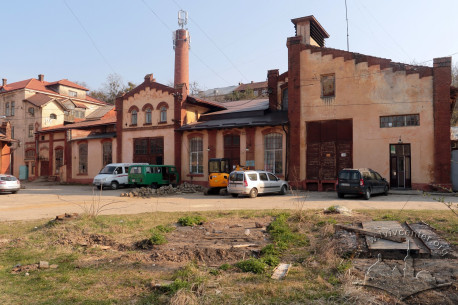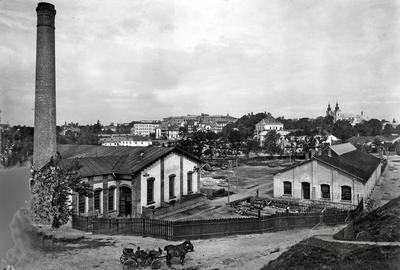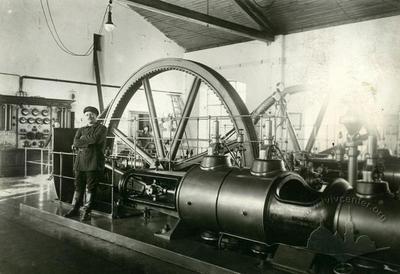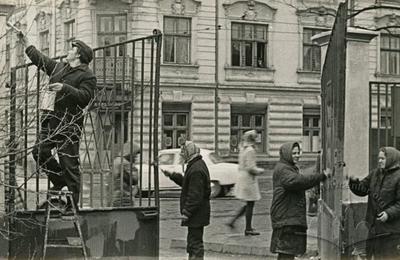Vul. Sakharova, 1 – former direct current power plant ID: 2636
This was the first power plant in the city, built in 1894 to supply the electric tram line leading to the Provincial Exhibition in the Stryiskyi Park. Subsequently, the power plant fed the expanded tram network and lit a number of objects in the city as well. After the construction of a power plant at Persenkówka and the arrangement of the city-wide alternative current (AC) grid, the direct current (DC) power plant ceased to operate in 1916. Today, it is from this building that the power supply network of the municipal electric transport is operated.
Story
It was planned to open the Provincial Exhibition in Lviv's Stryiskyi Park in 1894. In 1892 the Lviv Magistrate offered the directorate of the horse-drawn tram to build a new tramline to the exhibition. Considering that after the exhibition the route would be unprofitable, the company refused. After the exhibition was closed, this route was suspended for some time indeed. However, the refusal was a strategic mistake of the horse-drawn tram company management.
Roman Dzieślewski, a professor and later rector of the Lviv Polytechnic, suggested at once that the city authorities should build an electric tramline to compete with the horse-drawn tram and to gradually displace it. Dzieślewski actively promoted electric novelties. Less than a year earlier, he was appointed the head of the newly established department of electrical engineering at the Lviv Polytechnic.
Dzieślewski was included in the Magistrate's working group, which studied the experience of how electric trams operate in Europe. They published the results in 1892. This report included aproposalto constructsuch a tram line in Lviv, prepared by Roman Dzieślewski and Juliusz Hochberger, the head of the Magistrate's Construction Direction.
Wulecka street (today, Sakharova) was chosen for the location of the power plant, due to its approximately same distance to the railway station, the city center and the Stryiskyi Park. The choice proved successful, providing an optimal distance from the power source along the entire tramline.
Following 15 meetings taking place during 1892-1893, the City Council approved the construction of an electric tram on 18 April 1893. Realizing his mistake, the director of the horse-drawn tram protested against the construction of an electric tram, as it allegedly did not comply with his current agreement with the Magistrate. In turn, the Magistrate referred to a specific paragraph of the resolution stating that "the city has the right to build all kinds of tracks, different from those on horsepower." Nevertheless, there were rumours going round that there would be no electric tram in the city.
Roman Dzieślewski made a brilliant tactical move then. His older brother, Walerian Dzieślewski, a licensed private civil engineer, appealed to the Magistrate on behalf of a consortium headed by Prince Adam Sapieha and registered with the Austrian Ministry of the Interior requesting a concession for the construction of a central power plant for the needs of the city tram, as well as for electricity supply for lighting, "in case the community of the city of Lviv did not intend to do it". In his request, Walerian Dzieślewski asked to reserve the consortium's priority if anybody else applied for such a concession or "permission to use paved roads or streets for the construction of electric lines." At that time the community did not promise or grant priorities to anyone. However, it became clear that if the city did not build an electric tram, a private company would. And then the same problem as with the private horse-drawn tram directorate would recur.
In accordance with the agreement with the Magistrate, the Viennese joint-stock company Siemens&Halske built a DC power plant with a capacity of 400 horsepower (hp), consisting of two steam-electric units with a capacity of 200 hp each. In contemporary units, this corresponded to a power of 300 kW. To provide the generators with water cooling, a cooling tower was built. The works started in September 1893. Aleks Kern, an engineer from Vienna, was appointed the commissioner for the power plant's construction; he also became the plant's directot after it was put into operation. Józef Tomicki became his assistant. The first steam-electric unit was tested on 22 February 1894. The DC power plant began to work on 31 May 1894, simultaneously with the electric tram.
Lviv Magistrate bought out the power plant and the tram in 1896, on 7 August. An Electricity Commission was founded to manage the electric company. It consisted of nine persons with the right of a deciding vote (Roman Dzieślewski among them) and three with a consultative vote. The director of the electric tram was among them. Karol Schayer, a vice president of Lviv, headed this commission. Their first meeting was held on 30 July 1896. Alex Kern retained his post of director. Less than a year later, however, he applied for a long-term leave to undergo a course of treatment. On 14 June 1897 the Magistrate suggested that the Viceregency should appoint Józef Tomicki to replace Kern.
Soon, another consumer was connected to the power plant in addition to the tram. It was 12 arc lamps for the night-time illumination of an ice skating rink on the nearby Panieński pond. The electricity meter was not installed there. The price was set by the Municipal Electricity Commission for the entire winter period of 1897/1898: a total of 1,200 Rhenish guldens was to be paid. The payment was split into two parts, 1 December 1897 and 1 February 1898.
The fuel for the power plant was the fuel oil from Boryslav. A company of Zygmunt Rodakowski from Lviv won the tender for its delivery. Subsequently, in 1907, this company also won the tender for the construction of AC cable lines in Lviv. First, Rodakowski's company was located on Sykstuska street 26 (today, vul. Doroshenka) and later on the Smolki square 4 (pl. Henerala Hryhorenka).
In 1900 the power plant was expanded due to the connection of the city theater and other consumers in the city's center. In 1903 batteries of Zdzisław Stanecki, a Lviv businessman, were installed at the power plant to level the voltage and current fluctuation in the traction network when the tram started moving and made turns or ascents as it was dangerous for the generator. Zdzisław Stanecki, a former first assistant of professor Dzieślewski at the Department of Electrical Engineering in 1893-1901, had his own company on Kopernika street 46. The next enlargement of the power plant took place in 1906 due to the opening of new tram routes.
In 1909 a new AC power plant was put into operation at Persenkówka (today, Lviv Heat Power Plant No. 1). Rectifiers were installed at the old power plant on Sakharova street, which provided additional direct current for the needs of the tram and lighting network. A cable line from the new power plant was laid as well.
After the introduction of the city's AC mains, a gradual dismantling of the DC network began. In 1916 the DC power plant ceased its work. In its place, a rectifying substation for the tram traction electric power supply was left, which has been operating till now.
At the time when the first Lviv power plant was under construction, the world was already aware of the advantages of alternating current, which allowed the supply of electricity at greater distances. However, in Lviv, a DC power plant was built first, probably due to the fact that the electric tram traction needed a constant voltage of 500 V. The use of electricity for lighting homes in the more remote areas from the power plant was not in question at the time. Perhaps it was considered, but, as this would require the construction of an AC grid with transformer substations, which meant a lot of money and, there was not enough time. Instead, the first needs, i.e. lighting the exhibition and transporting visitors from the railway station to the Stryiskyi park with an electric tram, could be provided by a DC power plant.
Related buildings and spaces
People
Roman Dzieślewski (1863-1924) — a professor of the Lviv Polytechnic, the first head of the electrical engineering department, rector in 1901-1902. One of the initiators of the electric tram construction in Lviv.






















